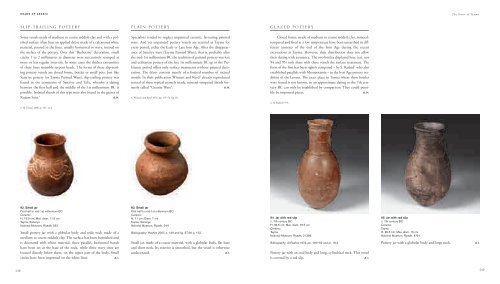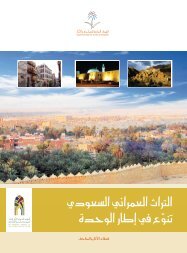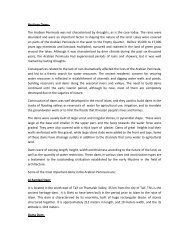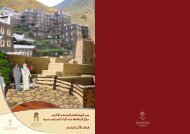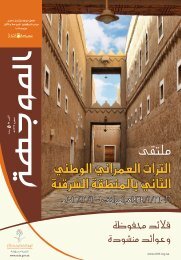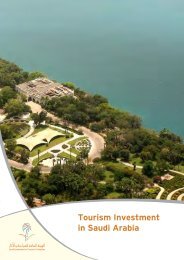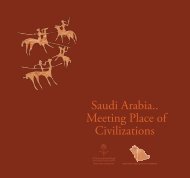Roads of Arabia
Roads of Arabia
Roads of Arabia
Create successful ePaper yourself
Turn your PDF publications into a flip-book with our unique Google optimized e-Paper software.
14 Arabie US_p218-261.qxd 23/06/10 21:52 Page 248<br />
ROADS OF ARABIA<br />
The Oasis <strong>of</strong> Tayma<br />
SLIP-TRAILING POTTERY<br />
PLAIN POTTERY<br />
GLAZED POTTERY<br />
Some vessels made <strong>of</strong> medium to coarse reddish clay and with a polished<br />
surface <strong>of</strong>ten bear an applied décor made <strong>of</strong> a calcareous white<br />
material, poured in the lines, usually horizontal or wavy, incised on<br />
the surface <strong>of</strong> the pottery. Over this “Barbotine” decoration, small<br />
circles 1 to 2 millimetres in diameter were successively stamped at<br />
more or less regular intervals. In some cases the thicker extremities<br />
<strong>of</strong> these lines resemble serpent heads. The forms <strong>of</strong> these slip-trailing<br />
pottery vessels are closed forms, bottles or small pots. Just like<br />
Sana’iye pottery (or Tayma Painted Ware), slip-trailing pottery was<br />
found in the cemeteries <strong>of</strong> Sana’iye and Tal’a, whereby a dating<br />
between the first half and the middle <strong>of</strong> the 1st millennium BC is<br />
possible. Isolated sherds <strong>of</strong> this type were also found in the graves <strong>of</strong><br />
Rujum Sa’sa. 1 A. H.<br />
Specialists tended to neglect unpainted ceramic, favouring painted<br />
ware. And yet unpainted pottery vessels are attested at Tayma for<br />
every period, either the Early or Late Iron Age. After the disappearance<br />
<strong>of</strong> Sana’iye ware (Tayma Painted Ware), that is, probably after<br />
the mid-1st millennium BC the tradition <strong>of</strong> painted pottery was lost<br />
and utilitarian pottery <strong>of</strong> the late 1st millennium BC up to the Pre-<br />
Islamic period <strong>of</strong>fers only surface treatments without painted decoration.<br />
The décor consists merely <strong>of</strong> a limited number <strong>of</strong> incised<br />
motifs. In their publication Winnett and Reed 1 already reproduced<br />
several <strong>of</strong> these typical coarsely made, mineral-tempered sherds formerly<br />
called “Granite Ware”. A. H.<br />
1. Winnett and Reed 1970, pp. 175–76, fig. 85.<br />
Closed forms, made <strong>of</strong> medium to coarse reddish clay, mineraltempered<br />
and fired at a low temperature have been unearthed in different<br />
contexts <strong>of</strong> the end <strong>of</strong> the Iron Age during the recent<br />
excavations at Tayma. However, their distribution does not allow<br />
their dating with assurance. The two bottles displayed here (cat. nos<br />
94 and 95) only share with these vessels the surface treatment. The<br />
form <strong>of</strong> the first has been rightly compared – by S. Rashid 1 who also<br />
established parallels with Mesopotamia – to the Iron Age pottery tradition<br />
<strong>of</strong> the Levant. The exact place in Tayma where these bottles<br />
were found is not known, so an approximate dating to the 7th century<br />
BC can only be established by comparison. They could possibly<br />
be imported pieces. A. H.<br />
1. Al-Rashid 1974.<br />
1. Al-Taima’i 2006, p. 131, no.3.<br />
92. Small jar<br />
First half to mid-1st millennium BC<br />
Ceramic<br />
H. 19.5 cm; Max. diam. 11.5 cm<br />
Tayma, Sana’iye<br />
National Museum, Riyadh, 533<br />
Small pottery jar with a globular body and wide neck made <strong>of</strong> a<br />
medium to coarse reddish clay. The surface has been burnished and<br />
is decorated with white material: three parallel, horizontal bands<br />
have been set at the base <strong>of</strong> the neck, while three wavy ones are<br />
located directly below them, on the upper part <strong>of</strong> the body. Small<br />
circles have been impressed on the white lines. A. I.<br />
93. Small jar<br />
First half to mid-1st millennium BC<br />
Ceramic<br />
H. 11 cm; Diam. 7 cm<br />
Tayma, Sana’iye<br />
National Museum, Riyadh, 544<br />
Bibliography: Hashim 2007, p. 149 and fig. 5T:26 p. 152.<br />
Small jar, made <strong>of</strong> a coarse material, with a globular body, flat base<br />
and short neck. Its exterior is smoothed, but the vessel is otherwise<br />
undecorated. A. I.<br />
94. Jar with red slip<br />
c. 7th century BC<br />
H. 34.5 cm; Max. diam. 16.5 cm<br />
Ceramic<br />
Tayma<br />
National Museum, Riyadh, 21386<br />
Bibliography: Al-Rashid 1974, pp. 160–62 and pl. 19.3.<br />
Pottery jar with an oval body and long, cylindrical neck. This vessel<br />
is covered by a red slip. A. I.<br />
95. Jar with red slip<br />
c. 7th century BC<br />
Ceramic<br />
Tayma<br />
H. 26.5 cm; Max. diam. 15 cm<br />
National Museum, Riyadh, 4791<br />
Pottery jar with a globular body and large neck. A. I.<br />
248<br />
249


